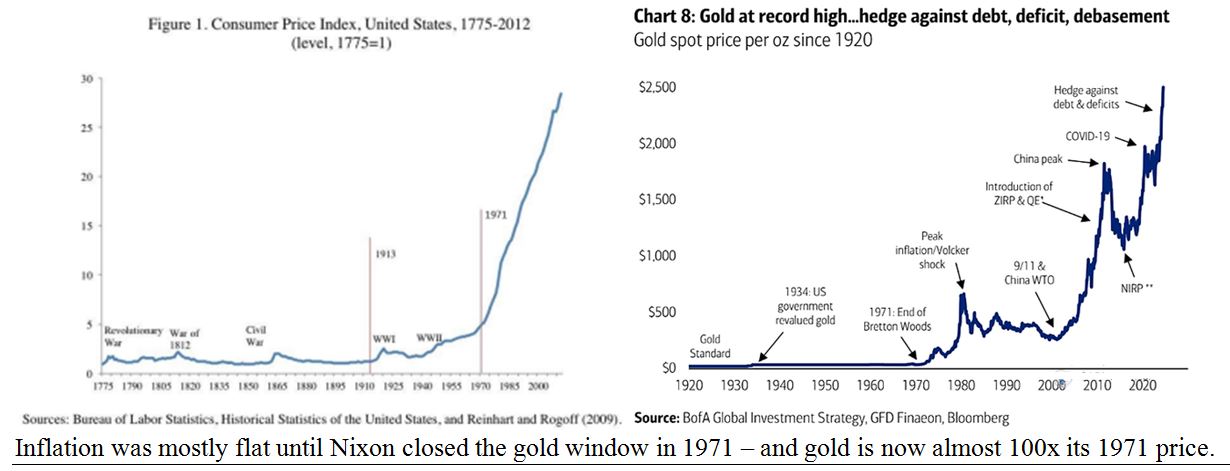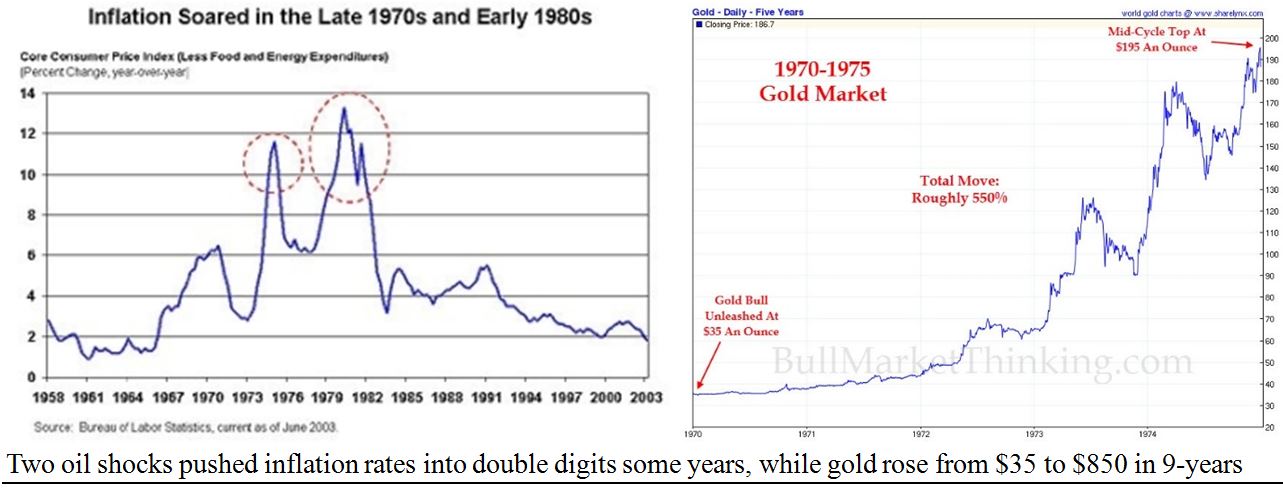by Gary Alexander
August 12, 2025
In the last two-weeks, I’ve covered the positives and negatives of historical August market hurricanes, and how August went from being the market’s best month for over nearly a century, then became our worst month in recent decades. Today, I’d like to profile two mid-August market milestones from long ago, both falling on Friday, August 13: (1) Nixon’s Camp David meeting to close the gold window in 1971, and (2) The birth of the biggest bull market of our lifetimes on August 13, 1982. In between those two epic events, the stock market tanked in real (after-inflation) terms, as gold soared and the dollar sank.
The Nixon Gold Shock of August 13-15, 1971
Over the last few days, gold has set its most meaningful all-time high to date – at $3,500+ per ounce, 100-times its fixed $35-price from 1934 to 1971. So, in gold terms, a 2025 dollar is worth just a 1970 penny.
That story began on this date in history: On Thursday, August 12, 1971, President Nixon informed 15-key officials on his team to pack an overnight bag and be prepared to go away for the weekend – destination not disclosed – and they were forbidden from telling anyone, even their spouses, what it was all about.
On Friday the 13th, those 15-key officials were ferried on two-huge helicopters from the White House to Camp David, some 65-miles north. Top officials included Federal Reserve Chairman Arthur Burns, Treasury Secretary John Connally and Undersecretary for International Monetary Affairs Paul Volcker, along with key political aides John Ehrlichman and H.R Haldeman. Their main goal was to stop the gold drain that had arisen from the “two tier” gold price of $35 per-ounce for central banks and a market price of over $40 for private buyers (outside the U.S., where it was still illegal for U.S. citizens to own gold-bullion).
Savvy governments were buying U.S. gold at $35, only to sell it for a quick 20% profit, the perfect crime. Many nations pledged not to take advantage of the U.S. Treasury’s gold drain, but some secretly bought as much gold as they could, so President Nixon needed to “close the gold window” for these arbitrageurs.
That weekend, on Sunday, August 15, 1971, President Nixon pre-empted the most popular TV show in America, Bonanza, to tell the nation via a special TV address that he not only closed the gold window, but effectively devalued the dollar 20% from its $35 fixed-price, while engaging in a diversionary action by issuing wage and price controls for 90-days, despite low (3%) inflation rates, plus a 10% surtax (tariff) on imports. The American public and press loved these moves, for some odd reason, since the “candy” in the package was freezing out any price increases, plus an import tax, delaying any further dollar devaluations.
The Nixon team had not leaked any of this plan in advance. They also failed to warn any of our major trading partners or the IMF in advance, so it became known in history as “The Nixon Shock.” But the shock was positive at home. On Monday morning, the Dow Jones index enjoyed its largest one-day point gain in history, to that date, up 33-points, and rising over 5% in the first two-days after the Nixon Shock. (Sources: “Three Days at Camp David,” by Jeffrey E. Garten, and “Currency Wars” by James Rickards).

As an economics reporter for a major magazine in 1971, I had expected such a move, after reading Harry Browne’s 1970 book, “How You Can Profit from the Coming Devaluation,” so I stayed up late that Sunday night in our closet filled with three news ticker-tapes by AP (Associated Press), UPI (United Press International) and our newest tape, from Reuters. I was monitoring global reaction for a quick article in the magazine, due the next day. After the buoyant market reaction on Monday, I knew the real story was a future decline in the dollar, along with higher inflation and a gold market, but most pundits didn’t see that.

As I summarized the public reaction back then: “A poll of 220-households by Albert E. Sindlinger & Co., on Monday revealed 75% of Americans favored the president’s proposals, while most of those who dissented did so on the grounds that Mr. Nixon’s actions should have come sooner. Albert Sindlinger’s amazed reaction was, ‘In all the years I’ve been doing this business – more than 15 – I’ve never seen anything this unanimous, unless maybe it was Pearl Harbor” (from “Initial Reaction to Nixon’s Economic Plan,” by Gary Alexander, Plain Truth Magazine, September 1971). A month later, in the October issue, I wrote a longer article, on “America’s Dollar Crisis,” spelling out the negative long-term implications.

Graphs are for illustrative and discussion purposes only. Please read important disclosures at the end of this commentary.
In 1971, I quickly learned that at least three other men were outraged by Nixon’s moves – listed below – not counting the writers, actors and advertisers of “Bonanza,” the TV show pre-empted by the speech.
In that show, “Pa” (Lorne Greene) and his three sons Adam (Pernell Roberts) “Hoss” (Dan Blocker) and “Little Joe” (Michael Landon) would not understand a revaluation of the gold dollars in their pockets.
In addition, here are some brave gents – whom I later worked with – who reacted with an action plan.
- Robert D. Kephart (1935-2004), publisher of Human Events, launched the Inflation Survival Letter in late 1971 to help investors profit from the inflation to come. (In 1981, I worked for Kephart).
- James U. Blanchard III (1943-1999), a high school American History teacher in New Orleans, was so outraged that he quit his teaching job to form the National Committee to Legalize Gold, launching “Gold Newsletter” that fall, mostly born from a mailing list of the Gold Club my dad attended in Seattle. (I also later worked for Blanchard’s company, editing Gold Newsletter from 1983 to 1989).
- Libertarian activist David Nolan (1943-2010) was so outraged by Nixon’s move that he created the Libertarian Party in his home in late 1971. (I later worked with LP candidate Harry Browne (1933-2006) in his Presidential candidacy of 1996, and I ran for office on the LP banner myself in 1997).
These brave dissenters saw the 1970s challenges clearly, in advance, with inflation eroding any meager stock market gains, while “real things” (like metals, commodities or real estate) beat stocks and bonds.

The dollar also fell sharply in the rest of the 1970s:


Graphs are for illustrative and discussion purposes only. Please read important disclosures at the end of this commentary.
Friday, August 13, 1982 – Birth of the Greatest Bull Market of Our Lifetime
After the incoming Reagan team endured two deep back-to-back recessions and a market swoon, August 12, 1982, marked a major market low, 43-years ago today. After that, from a Las Vegas-style lucky low of Dow “777,” the bull market grew 15-fold in less than 18-years. Yes, that mega bull market was born on a Friday the 13th, in the 13th consecutive quarter of negative growth. Our 11-year market swoon was over.
(This is already too long, so I’ll continue this second dramatic Friday, August the 13th saga next week).
All content above represents the opinion of Gary Alexander of Navellier & Associates, Inc.
Also In This Issue
A Look Ahead by Louis Navellier
President Trump Begins to “Rebuild” the Fed Board
Income Mail by Bryan Perry
Mining the Fundamentals of the Key Market Trends
Growth Mail by Gary Alexander
Two Freaky Friday the 13th Markets Changed America
Global Mail by Ivan Martchev
Last Week’s “Reversal of the Reversal”
Sector Spotlight by Jason Bodner
Volatility Season Has Officially Begun
View Full Archive
Read Past Issues Here
About The Author

Gary Alexander
SENIOR EDITOR
Gary Alexander has been Senior Writer at Navellier since 2009. He edits Navellier’s weekly Marketmail and writes a weekly Growth Mail column, in which he uses market history to support the case for growth stocks. For the previous 20 years before joining Navellier, he was Senior Executive Editor at InvestorPlace Media (formerly Phillips Publishing), where he worked with several leading investment analysts, including Louis Navellier (since 1997), helping launch Louis Navellier’s Blue Chip Growth and Global Growth newsletters.
Prior to that, Gary edited Wealth Magazine and Gold Newsletter and wrote various investment research reports for Jefferson Financial in New Orleans in the 1980s. He began his financial newsletter career with KCI Communications in 1980, where he served as consulting editor for Personal Finance newsletter while serving as general manager of KCI’s Alexandria House book division. Before that, he covered the economics beat for news magazines. All content of “Growth Mail” represents the opinion of Gary Alexander
Important Disclosures:
Although information in these reports has been obtained from and is based upon sources that Navellier believes to be reliable, Navellier does not guarantee its accuracy and it may be incomplete or condensed. All opinions and estimates constitute Navellier’s judgment as of the date the report was created and are subject to change without notice. These reports are for informational purposes only and are not a solicitation for the purchase or sale of a security. Any decision to purchase securities mentioned in these reports must take into account existing public information on such securities or any registered prospectus.To the extent permitted by law, neither Navellier & Associates, Inc., nor any of its affiliates, agents, or service providers assumes any liability or responsibility nor owes any duty of care for any consequences of any person acting or refraining to act in reliance on the information contained in this communication or for any decision based on it.
Past performance is no indication of future results. Investment in securities involves significant risk and has the potential for partial or complete loss of funds invested. It should not be assumed that any securities recommendations made by Navellier. in the future will be profitable or equal the performance of securities made in this report. Dividend payments are not guaranteed. The amount of a dividend payment, if any, can vary over time and issuers may reduce dividends paid on securities in the event of a recession or adverse event affecting a specific industry or issuer.
None of the stock information, data, and company information presented herein constitutes a recommendation by Navellier or a solicitation to buy or sell any securities. Any specific securities identified and described do not represent all of the securities purchased, sold, or recommended for advisory clients. The holdings identified do not represent all of the securities purchased, sold, or recommended for advisory clients and the reader should not assume that investments in the securities identified and discussed were or will be profitable.
Information presented is general information that does not take into account your individual circumstances, financial situation, or needs, nor does it present a personalized recommendation to you. Individual stocks presented may not be suitable for every investor. Investment in securities involves significant risk and has the potential for partial or complete loss of funds invested. Investment in fixed income securities has the potential for the investment return and principal value of an investment to fluctuate so that an investor’s holdings, when redeemed, may be worth less than their original cost.
One cannot invest directly in an index. Index is unmanaged and index performance does not reflect deduction of fees, expenses, or taxes. Presentation of Index data does not reflect a belief by Navellier that any stock index constitutes an investment alternative to any Navellier equity strategy or is necessarily comparable to such strategies. Among the most important differences between the Indices and Navellier strategies are that the Navellier equity strategies may (1) incur material management fees, (2) concentrate its investments in relatively few stocks, industries, or sectors, (3) have significantly greater trading activity and related costs, and (4) be significantly more or less volatile than the Indices.
ETF Risk: We may invest in exchange traded funds (“ETFs”) and some of our investment strategies are generally fully invested in ETFs. Like traditional mutual funds, ETFs charge asset-based fees, but they generally do not charge initial sales charges or redemption fees and investors typically pay only customary brokerage fees to buy and sell ETF shares. The fees and costs charged by ETFs held in client accounts will not be deducted from the compensation the client pays Navellier. ETF prices can fluctuate up or down, and a client account could lose money investing in an ETF if the prices of the securities owned by the ETF go down. ETFs are subject to additional risks:
- ETF shares may trade above or below their net asset value;
- An active trading market for an ETF’s shares may not develop or be maintained;
- The value of an ETF may be more volatile than the underlying portfolio of securities the ETF is designed to track;
- The cost of owning shares of the ETF may exceed those a client would incur by directly investing in the underlying securities; and
- Trading of an ETF’s shares may be halted if the listing exchange’s officials deem it appropriate, the shares are delisted from the exchange, or the activation of market-wide “circuit breakers” (which are tied to large decreases in stock prices) halts stock trading generally.
Grader Disclosures: Investment in equity strategies involves substantial risk and has the potential for partial or complete loss of funds invested. The sample portfolio and any accompanying charts are for informational purposes only and are not to be construed as a solicitation to buy or sell any financial instrument and should not be relied upon as the sole factor in an investment making decision. As a matter of normal and important disclosures to you, as a potential investor, please consider the following: The performance presented is not based on any actual securities trading, portfolio, or accounts, and the reported performance of the A, B, C, D, and F portfolios (collectively the “model portfolios”) should be considered mere “paper” or pro forma performance results based on Navellier’s research.
Investors evaluating any of Navellier & Associates, Inc.’s, (or its affiliates’) Investment Products must not use any information presented here, including the performance figures of the model portfolios, in their evaluation of any Navellier Investment Products. Navellier Investment Products include the firm’s mutual funds and managed accounts. The model portfolios, charts, and other information presented do not represent actual funded trades and are not actual funded portfolios. There are material differences between Navellier Investment Products’ portfolios and the model portfolios, research, and performance figures presented here. The model portfolios and the research results (1) may contain stocks or ETFs that are illiquid and difficult to trade; (2) may contain stock or ETF holdings materially different from actual funded Navellier Investment Product portfolios; (3) include the reinvestment of all dividends and other earnings, estimated trading costs, commissions, or management fees; and, (4) may not reflect prices obtained in an actual funded Navellier Investment Product portfolio. For these and other reasons, the reported performances of model portfolios do not reflect the performance results of Navellier’s actually funded and traded Investment Products. In most cases, Navellier’s Investment Products have materially lower performance results than the performances of the model portfolios presented.
This report contains statements that are, or may be considered to be, forward-looking statements. All statements that are not historical facts, including statements about our beliefs or expectations, are “forward-looking statements” within the meaning of The U.S. Private Securities Litigation Reform Act of 1995. These statements may be identified by such forward-looking terminology as “expect,” “estimate,” “plan,” “intend,” “believe,” “anticipate,” “may,” “will,” “should,” “could,” “continue,” “project,” or similar statements or variations of such terms. Our forward-looking statements are based on a series of expectations, assumptions, and projections, are not guarantees of future results or performance, and involve substantial risks and uncertainty as described in Form ADV Part 2A of our filing with the Securities and Exchange Commission (SEC), which is available at www.adviserinfo.sec.gov or by requesting a copy by emailing info@navellier.com. All of our forward-looking statements are as of the date of this report only. We can give no assurance that such expectations or forward-looking statements will prove to be correct. Actual results may differ materially. You are urged to carefully consider all such factors.
FEDERAL TAX ADVICE DISCLAIMER: As required by U.S. Treasury Regulations, you are informed that, to the extent this presentation includes any federal tax advice, the presentation is not written by Navellier to be used, and cannot be used, for the purpose of avoiding federal tax penalties. Navellier does not advise on any income tax requirements or issues. Use of any information presented by Navellier is for general information only and does not represent tax advice either express or implied. You are encouraged to seek professional tax advice for income tax questions and assistance.
IMPORTANT NEWSLETTER DISCLOSURE:The hypothetical performance results for investment newsletters that are authored or edited by Louis Navellier, including Louis Navellier’s Growth Investor, Louis Navellier’s Breakthrough Stocks, Louis Navellier’s Accelerated Profits, and Louis Navellier’s Platinum Club, are not based on any actual securities trading, portfolio, or accounts, and the newsletters’ reported hypothetical performances should be considered mere “paper” or proforma hypothetical performance results and are not actual performance of real world trades. Navellier & Associates, Inc. does not have any relation to or affiliation with the owner of these newsletters. There are material differences between Navellier Investment Products’ portfolios and the InvestorPlace Media, LLC newsletter portfolios authored by Louis Navellier. The InvestorPlace Media, LLC newsletters contain hypothetical performance that do not include transaction costs, advisory fees, or other fees a client might incur if actual investments and trades were being made by an investor. As a result, newsletter performance should not be used to evaluate Navellier Investment services which are separate and different from the newsletters. The owner of the newsletters is InvestorPlace Media, LLC and any questions concerning the newsletters, including any newsletter advertising or hypothetical Newsletter performance claims, (which are calculated solely by Investor Place Media and not Navellier) should be referred to InvestorPlace Media, LLC at (800) 718-8289.
Please note that Navellier & Associates and the Navellier Private Client Group are managed completely independent of the newsletters owned and published by InvestorPlace Media, LLC and written and edited by Louis Navellier, and investment performance of the newsletters should in no way be considered indicative of potential future investment performance for any Navellier & Associates separately managed account portfolio. Potential investors should consult with their financial advisor before investing in any Navellier Investment Product.
Navellier claims compliance with Global Investment Performance Standards (GIPS). To receive a complete list and descriptions of Navellier’s composites and/or a presentation that adheres to the GIPS standards, please contact Navellier or click here. It should not be assumed that any securities recommendations made by Navellier & Associates, Inc. in the future will be profitable or equal the performance of securities made in this report.
FactSet Disclosure: Navellier does not independently calculate the statistical information included in the attached report. The calculation and the information are provided by FactSet, a company not related to Navellier. Although information contained in the report has been obtained from FactSet and is based on sources Navellier believes to be reliable, Navellier does not guarantee its accuracy, and it may be incomplete or condensed. The report and the related FactSet sourced information are provided on an “as is” basis. The user assumes the entire risk of any use made of this information. Investors should consider the report as only a single factor in making their investment decision. The report is for informational purposes only and is not intended as an offer or solicitation for the purchase or sale of a security. FactSet sourced information is the exclusive property of FactSet. Without prior written permission of FactSet, this information may not be reproduced, disseminated or used to create any financial products. All indices are unmanaged and performance of the indices include reinvestment of dividends and interest income, unless otherwise noted, are not illustrative of any particular investment and an investment cannot be made in any index. Past performance is no guarantee of future results.
